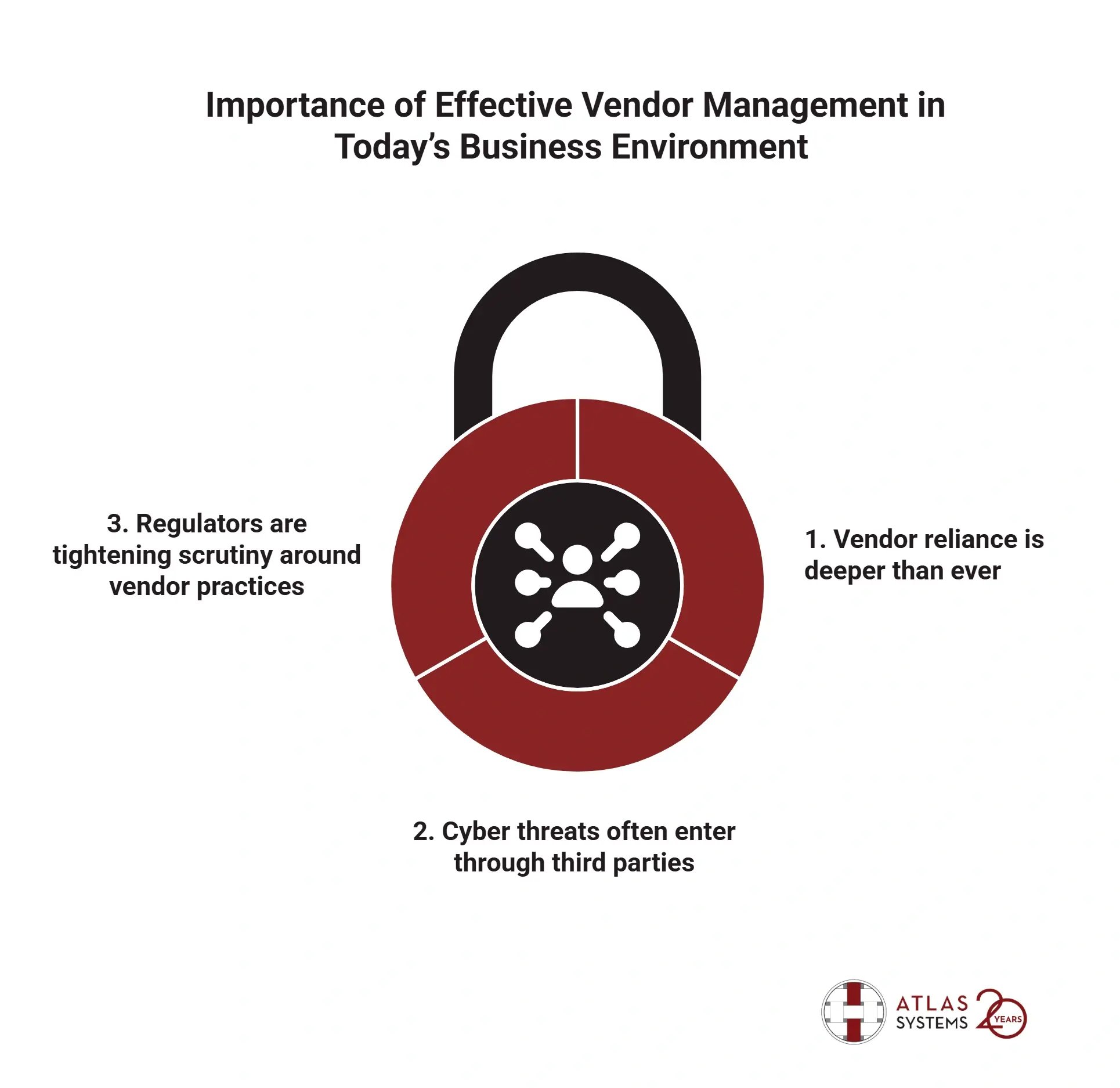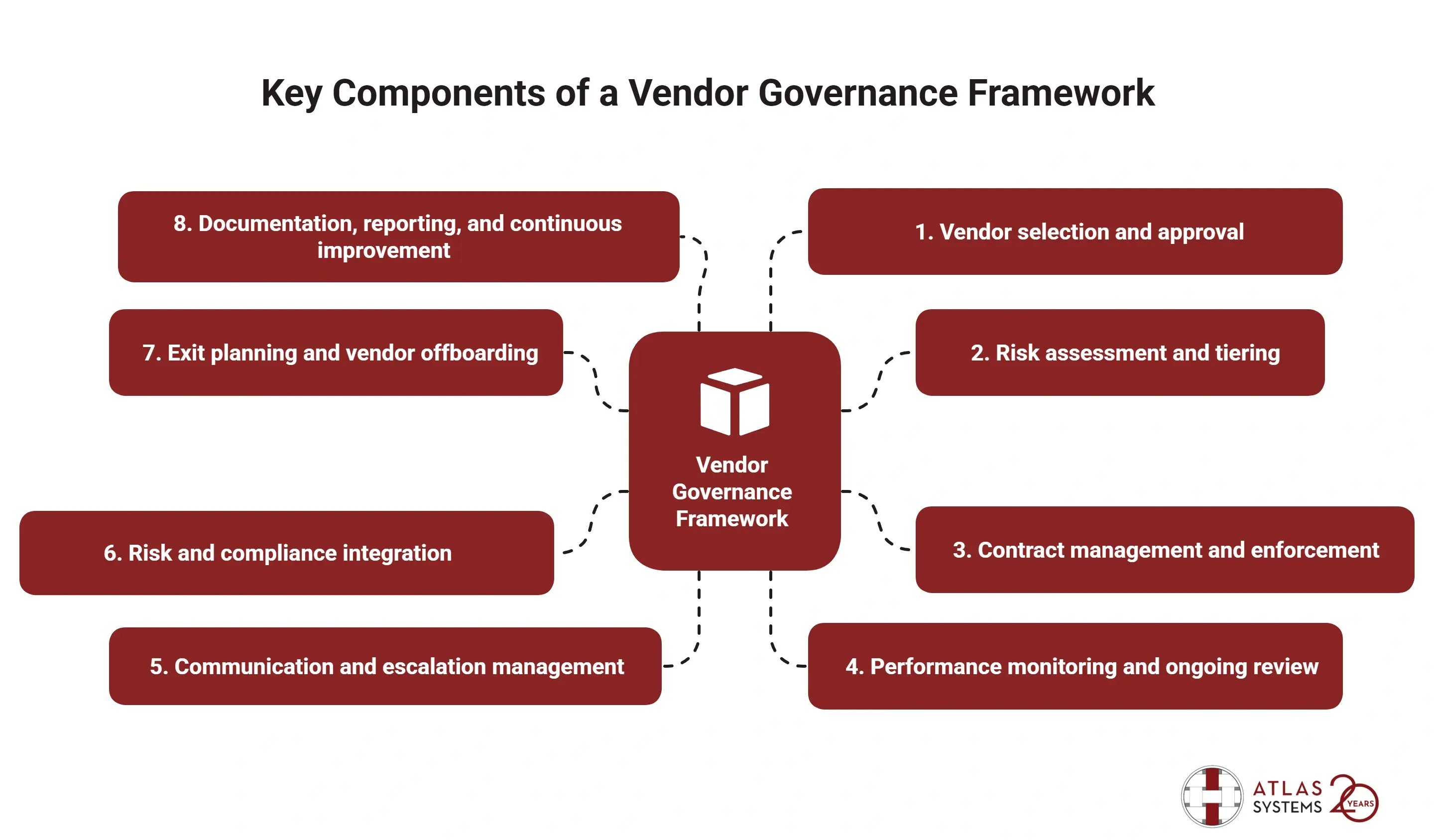You already depend on dozens of vendors, maybe more, to keep your operations running. Some days, it works smoothly. Other days, it feels like you are juggling risks you did not even sign up for.
Without a clear way to manage vendor relationships, small gaps can quietly turn into big problems like compliance failures, data leaks, and service delays that hit you when you can least afford them.
The truth is, managing vendors is messy if you treat it like a background task. What you need is a simple but organized way to stay in control, from the first handshake to the last invoice.
This guide walks you through what a vendor governance framework is, why it matters, and how to build one that actually works.
What is a Vendor Governance Framework?
A vendor governance framework is a structured system that organizations use to oversee, evaluate, and manage third-party vendors to maintain compliance, performance standards, and risk control.
Managing vendors effectively is not just about cutting costs or signing contracts. It is about setting up a reliable structure that keeps your business protected while getting the most out of your external partnerships.
Here is what strong vendor governance typically involves:
- Choosing the right vendors
You need clear benchmarks for deciding which vendors are the right fit; not just anyone should make the list.
- Ongoing risk reviews
Risk reviews should go beyond surface checks. You want to dig into cybersecurity practices, regulatory compliance, financial strength, and how stable a vendor’s operations really are.
- Performance accountability
Clear service standards should be set up front and checked regularly, so there are no surprises when it matters most.
- Consistent communication
Defined points of contact and escalation paths make it easier to resolve problems before they escalate into disruptions.
- Exit planning
Even great partnerships can end. Having an exit plan protects your organization if a vendor relationship needs to change or close.
Importance of Effective Vendor Management in Today’s Business Environment
As vendor networks grow more complex, a strong governance framework is no longer optional; it is essential to managing risk, protecting operations, and maintaining compliance across your entire business landscape.
Vendor relationships are more complicated today than they used to be. Without a clear way to manage them, risks multiply quickly, operations become harder to protect, and meeting compliance standards turns into a constant uphill battle.
Working with outside vendors is not just about cutting costs anymore. For many companies, vendors now handle critical parts of everyday operations. As partnerships deepen, keeping control over who does what, and how, becomes just as important as managing in-house teams.
When vendor oversight slips, it does not take long for small issues to turn into bigger problems. A missed security patch here, a regulatory gap there, and suddenly the risks are not just technical anymore. They can threaten your reputation, financial stability, and standing with regulators.
Three key shifts make vendor management essential today:

- Vendor reliance is deeper than ever
Many organizations now rely on vendors for critical areas like IT support, shipping, and customer communications. That access goes deep, straight into company systems, private data, and even your customer relationships.
- Cyber threats often enter through third parties
A weak spot in a vendor’s security setup can open doors to your own systems. Threat actors increasingly target vendors because they are often an easier way in.
- Regulators are tightening scrutiny around vendor practices
Audits and investigations no longer stop at your internal processes. Regulatory bodies expect organizations to prove they are managing third-party risks with the same rigor as internal risks.
How Does a Vendor Governance Framework Help in Risk Mitigation?
A strong vendor governance framework does not eliminate risk completely. But it gives you a practical system to spot vulnerabilities early, set expectations clearly, and move faster when something goes wrong.
Here are a few critical areas where a vendor governance framework strengthens your defense:
- Data security risks
By setting cybersecurity expectations with vendors and reviewing them regularly, you lower the chances of breaches caused by weak third-party defenses.
- Compliance gaps
Governance connects vendor activities directly to regulatory obligations, making it easier to prevent hidden compliance failures before they escalate.
- Service delivery failures
Defined performance standards and active monitoring help you catch slippage early, not after it affects your operations or customers.
- Financial and reputational risks
When you build regular risk checks into your vendor process, it gets easier to spot red flags early, like shaky finances, missed deadlines, or poor security practices, before they turn into bigger problems.
Key Components of a Vendor Governance Framework
Managing vendors demands an organized system that covers every phase of the relationship, from selecting the right partners to eventually winding down partnerships safely.
Good governance moves vendor oversight from reactive fire drills to proactive protection. It gives your teams more control, clearer insights, and fewer unwelcome surprises when vendor-related issues arise.
These core components form the foundation of a vendor governance framework that actually works in real-world conditions:

1. Vendor selection and approval
Choosing the right vendors is the first real safeguard against downstream risk. Cost matters, but so does security, compliance, and long-term fit. A smart selection process does not leave these factors to chance.
Key points:
- Define objective criteria like financial stability, cybersecurity posture, operational capacity, and industry reputation.
- Involve multiple stakeholders, including IT, legal, compliance, and business unit leaders, during vendor selection.
- Create standardized sourcing guidelines, especially for complex categories like SaaS or IT infrastructure purchases.
- Ensure vendor approval steps are documented, traceable, and scalable as your organization grows.
2. Risk assessment and tiering
Every vendor relationship carries a different level of risk. Building a flexible governance framework means adjusting oversight based on how critical or risky each vendor actually is.
Key points:
- Perform initial risk assessments based on access to sensitive data, regulatory exposure, financial impact, and operational dependencies.
- Tier vendors into categories (e.g., high-risk, medium-risk, low-risk) for appropriate monitoring intensity.
- Formalize risk scoring criteria to ensure consistency across teams and vendor types.
- Reassess risk periodically, not just at onboarding, especially after service changes, breaches, or regulatory shifts.
3. Contract management and enforcement
Clear, enforceable contracts are your best tool for holding vendors to their promises. A strong contract makes rights, obligations, and protections explicit, long before conflicts arise.
Key points:
- Specify service levels (SLAs), security requirements, performance reporting expectations, and compliance obligations upfront.
- Include clauses covering audits, breach notifications, liability, indemnification, and exit procedures.
- Centralize contract management, either through vendor management software or structured internal processes, to avoid fragmentation and lost visibility.
- Review and update contracts as business needs and regulations evolve.
4. Performance monitoring and ongoing review
Defining KPIs and service benchmarks sets expectations early, but real protection comes from checking in regularly to make sure vendors stay on track.
Key points:
- Establish KPIs tailored to each vendor’s critical services, with regular performance scorecards.
- Conduct quarterly or semi-annual vendor reviews based on risk tier.
- Integrate real-time monitoring tools where applicable (especially for IT and cybersecurity vendors).
- Track and investigate complaints, incidents, and service degradations early to prevent escalation.
5. Communication and escalation management
Vendor governance falls apart fast without clear communication. Coordination between procurement, IT, legal, compliance, and business units is not optional, it is foundational.
Key points:
- Assign a dedicated relationship owner for each key vendor to manage daily coordination and performance discussions.
- Set clear internal escalation paths for both operational disruptions and strategic disputes.
- Schedule regular touchpoints with vendors, not just during contract renewals or emergencies.
- Document and standardize escalation procedures so everyone knows when and how to raise alarms.
6. Risk and compliance integration
Vendor governance cannot be separated from broader risk management efforts. Strong frameworks weave third-party risk management directly into organizational compliance and continuity programs.
Key points:
- Align vendor governance policies with overarching regulatory compliance frameworks (GDPR, HIPAA, PCI DSS, etc.).
- Tie vendor risk monitoring to enterprise-wide cybersecurity and disaster recovery planning.
- Perform vendor audits in parallel with internal audits to maintain consistency.
- Update vendor governance practices dynamically as laws, risks, and organizational strategies change.
7. Exit planning and vendor offboarding
Planning how vendor exits will work, whether friendly or unexpected, protects your operations, your customers, and your data before problems happen.
Key points:
- Define vendor exit criteria clearly in contracts, including data migration and destruction obligations.
- Create detailed exit checklists covering service continuity, security handoffs, and intellectual property rights.
- Assign clear roles for exit management during vendor transitions to avoid confusion.
- Test exit plans periodically, especially for high-risk vendors handling critical services.
8. Documentation, reporting, and continuous improvement
Governance frameworks only work if they are documented, tested, and improved over time. This is not a "set it and forget it" discipline.
Key points:
- Maintain up-to-date vendor governance policies, procedures, and templates.
- Report regularly to senior management and boards on vendor risks, performance trends, and incidents.
- Conduct periodic internal and external audits of vendor management activities.
- Gather feedback from stakeholders and vendors to refine governance practices continuously.
Advantages of an Effective Vendor Management Framework
Managing vendors without a clear framework usually leads to confusion, wasted resources, and growing risk over time. When vendor management governance is structured and aligned with business goals, companies protect themselves while building stronger, more valuable partnerships.
Here’s what a well-designed framework helps you achieve:
1. Strategic focus that strengthens your business
Vendor management today is a strategic discipline, not just an operational task. A strong framework ensures that every vendor decision, from sourcing to renewal, supports your bigger-picture business goals.
Real-world advantages:
- Prioritize vendors that fuel innovation, speed-to-market, or customer experience gains.
- Allocate resources based on which vendors create the most impact, not just the biggest invoices.
- Build longer-term partnerships with suppliers who can grow and adapt alongside your organization.
2. Consistency and efficiency across all departments
Without a framework, every team handles vendors differently, creating blind spots and redundant processes. Governance brings much-needed consistency without slowing down progress.
Real-world advantages:
- Standardize sourcing, onboarding, compliance checks, and performance tracking across the enterprise.
- Use templates and shared workflows that make vendor management faster and less error-prone.
- Scale vendor operations confidently as the business grows without reinventing processes for every new project.
3. Better Communication, Stronger Collaboration
Vendors work best when expectations, feedback, and responsibilities are clear. A structured approach keeps both sides aligned before issues escalate.
Real-world advantages:
- Establish regular business reviews, service updates, and strategic planning sessions with key vendors.
- Create defined escalation paths so small service issues do not spiral into bigger operational problems.
- Foster a collaborative mindset where vendors feel accountable for solving problems, not just delivering invoices.
4. Smarter performance and risk management
Vendor performance and risk do not manage themselves. Frameworks ensure that teams are watching the right metrics and taking action early when needed.
Real-world advantages:
- Set and track KPIs tied directly to contract terms and business priorities.
- Monitor vendors proactively for emerging risks like financial instability, compliance drift, or service degradation.
- Use performance data to renegotiate terms, trigger corrective actions, or make informed renewal decisions.
5. Lower costs and higher value capture
Governance does more than avoid losses, it helps organizations capture real savings and performance upside from their vendors.
Real-world advantages:
- Avoid overspending by spotting contract overlaps, underperforming vendors, and bloated renewal costs.
- Speed up procurement cycles with standardized processes, reducing time-to-contract for new deals.
- Extract better service quality, better support, and more flexibility by managing vendors consistently and professionally.
6. Stronger compliance and risk defense
Vendor-related compliance failures are among the most expensive and damaging risks organizations face today. A framework gives compliance teams the visibility and control they need.
Real-world advantages:
- Align vendor contracts and practices with GDPR, HIPAA, PCI DSS, SOX, and other regulatory requirements.
- Simplify audit preparation by maintaining structured, up-to-date vendor records and assessments.
- Reduce exposure to fines, breaches, and reputational damage by monitoring third-party risks continuously.
7. Faster and safer vendor onboarding and offboarding
Transitions between vendors, or bringing new vendors online, are high-risk moments. A strong framework reduces the danger.
Real-world advantages:
- Accelerate onboarding by following consistent pre-assessment, due diligence, and compliance steps.
- Protect data and operational continuity with clear offboarding procedures when vendors exit.
- Ensure new vendors meet organizational standards before gaining access to sensitive systems or customer information.
8. Choosing the right framework structure
No single Vendor Management Framework fits every organization. Choosing the right structure and adapting it over time is key.
Common models:
- Centralized Framework
One core team handles all vendor governance tasks, creating consistency and speeding up decision-making.
- Best for: Highly regulated industries or companies with complex global vendor networks.
- Decentralized Framework
Business units manage their own vendor relationships independently, giving more autonomy and flexibility.
- Best for: Smaller or more agile organizations that need rapid, customized vendor handling.
-
- Watch out: Higher risk of fragmentation, duplication, and compliance gaps.
- Hybrid Framework
Combines centralized control over governance standards with decentralized execution at the business unit level.
- Best for: Large enterprises balancing standardization with local flexibility.
Whichever model you choose, the goal is the same: create enough structure to manage vendors smartly, without strangling the speed and innovation those vendors are supposed to deliver.
How to Develop a Strategic Vendor Management Framework
Here is a step-by-step approach to developing a framework that fits your organization:
1. Define your objectives and scope
Start by identifying what your vendor governance program must achieve and what types of vendors it will cover.
- Clarify primary goals (e.g., risk reduction, performance improvement, compliance assurance, cost control).
- Decide whether the framework will apply to all vendors or only critical/high-risk ones.
- Set success metrics early (e.g., audit pass rates, KPI compliance rates, cost savings).
2. Assemble a cross-functional governance team
Vendor management cannot live inside one department. It needs collaboration from multiple disciplines.
- Bring together leaders from procurement, IT, legal, compliance, risk management, and finance.
- Assign clear roles for policy ownership, vendor assessments, contract oversight, and escalation handling.
- Designate relationship owners for critical vendors who will manage day-to-day coordination.
3. Map the full vendor lifecycle
Effective frameworks manage vendors at every stage, not just at contract signing.
- Document processes for vendor sourcing, risk assessment, onboarding, monitoring, performance review, and offboarding.
- Identify key checkpoints (e.g., security reviews before onboarding, annual risk reassessments).
- Ensure lifecycle management adapts for different vendor tiers based on risk and criticality.
4. Develop core policies, templates, and playbooks
Standardization improves consistency and audit-readiness without adding friction.
- Create templates for vendor due diligence, contracts, service-level agreements (SLAs), and risk assessments.
- Develop escalation protocols and communication plans.
- Write policy guidelines that set minimum standards but allow flexibility for different vendor categories.
5. Implement tiered risk assessments
Not every vendor needs the same level of scrutiny. Risk-based approaches keep focus where it matters most.
- Classify vendors by impact level (e.g., critical infrastructure, data processors, non-critical services).
- Tailor onboarding, monitoring, and contract requirements based on risk category.
- Update risk profiles annually or after significant business or service changes.
6. Build monitoring, reporting, and escalation structures
Ongoing visibility separates effective frameworks from shelfware.
- Set up regular vendor performance reviews tied to KPIs and SLA measurements.
- Monitor compliance obligations continuously, not just during annual audits.
- Establish clear paths for escalating service issues, risk events, and non-compliance incidents.
7. Train internal teams and educate vendors
Frameworks only work if people follow them — and understand why they matter.
- Train employees involved in vendor management on policies, procedures, and expectations.
- Onboard vendors with clear guidance on performance, compliance, and escalation standards.
- Communicate regularly about updates to requirements or processes.
8. Pilot, test, and refine the framework
The first version of your framework will not be perfect, and that is expected.
- Roll out the framework to a select group of vendors first.
- Gather feedback from internal users and vendors on what works and where friction appears.
- Adjust policies, templates, and workflows before full-scale implementation.
9. Plan for ongoing improvement
Vendor governance is a living discipline, not a one-time project.
- Schedule regular reviews of framework effectiveness (annually at a minimum).
- Adjust for regulatory changes, market shifts, internal business evolution, and lessons learned.
- Incorporate continuous feedback loops from stakeholders and vendors themselves.
Best Practices for Establishing a Vendor Governance Framework
Even the best-designed vendor governance frameworks can struggle if they are not rolled out thoughtfully. To ensure lasting success, organizations need more than documentation — they need buy-in, practical execution, and a culture that treats vendor management as a shared responsibility.
Here are proven best practices for building a vendor governance program that actually delivers results:
- Start small, scale smart
Pilot your governance framework with a manageable group of vendors first. Gather real-world feedback before expanding to all vendor relationships.
- Focus governance where it matters most
Apply the strictest controls to high-risk or high-impact vendors. Keep lower-risk vendor processes efficient and proportionate.
- Get executive sponsorship early
Secure visible leadership support to give vendor governance initiatives the authority and resourcing they need to succeed.
- Align with broader risk and compliance programs
Integrate vendor governance into cybersecurity, operational risk management, and regulatory compliance efforts, not as a standalone process.
- Train internal stakeholders continuously
Vendor governance should not be confined to procurement teams. Business units, IT, compliance, and legal teams all need role-specific training.
- Make communication expectations explicit
Define who talks to vendors, how issues are escalated, and how performance feedback is delivered. Ambiguity breeds failure.
- Document everything and keep it current
Outdated vendor policies are almost as risky as having no policies. Review governance documentation regularly to ensure relevance and completeness.
- Use technology where it adds real value
Vendor management platforms can automate monitoring, flag risk trends, and streamline reporting, but only if processes are defined first.
- Treat vendor governance as a living system
Expect to adjust standards, templates, and oversight practices as your vendor landscape and risk environment evolve.
- Recognize and reward good vendor behavior
Vendor governance is not just about catching failures. Rewarding high-performing, compliant vendors strengthens trust and partnership longevity.
Challenges in Establishing a Vendor Governance Framework
Most teams underestimate how tricky vendor governance in third-party risk management can be until they start mapping real-world processes. What looks simple in a policy draft often turns messy once internal politics, competing priorities, and resource gaps get involved. Recognizing those pressure points early gives you a better shot at building something that actually works.
Here are some of the common challenges organizations face, and how to tackle them:
- Internal resistance to change
Many teams are comfortable managing vendors informally. Transitioning to structured governance can feel like an unnecessary burden.
Solution: Frame vendor governance as a business enabler, showing how it reduces manual work, speeds up decisions, and protects teams during audits.
- Lack of executive visibility and sponsorship
Without senior leadership backing, governance initiatives often lose priority.
Solution: Link vendor governance to core business risks (e.g., regulatory fines, service outages) and strategic goals to earn executive attention.
- Overcomplicating the framework
Trying to apply heavy governance to every vendor creates unnecessary drag.
Solution: Right-size oversight based on risk. High-risk vendors get full assessments; low-risk vendors have lighter processes.
- Siloed vendor management practices
Procurement, IT, and business units often manage vendors separately without shared standards.
Solution: Establish centralized governance policies that allow local execution flexibility while maintaining oversight consistency.
- Resource constraints
Building governance frameworks takes time, people, and technology, all of which may already be stretched.
Solution: Start lean with the highest-risk vendors, automate wherever possible, and expand coverage gradually.
- Vendor pushback
Some vendors may resist increased oversight, audits, or documentation requirements.
Solution: Communicate expectations early during onboarding. Reinforce governance terms contractually to avoid surprises later.
- Difficulty maintaining momentum over time
Initial governance enthusiasm can fade as business priorities shift.
Solution: Integrate vendor governance into regular audit cycles, risk reviews, and strategic planning processes so it stays active.
Build Smarter Vendor Oversight with Atlas Systems
Vendor risks will not wait for gaps to show, and regulators will not wait for excuses. Managing vendors without a clear framework leaves too much to chance, putting compliance, operations, and reputation on the line.
Atlas Systems helps organizations move beyond fragmented spreadsheets and scattered oversight. With solutions like ComplyScore® and customized governance frameworks, we deliver practical ways to monitor vendor risks, close compliance gaps, and create partnerships you can trust.
Ready to bring structure, control, and confidence to your vendor governance framework?
Contact us today!
FAQs about Vendor Governance Framework
1. How can organizations develop an effective Vendor Governance Framework?
Start by defining governance goals, assembling a cross-functional team, mapping the full vendor lifecycle, and setting clear risk-based policies. Focus on scalable processes, consistent monitoring, and building vendor accountability from onboarding to offboarding.
2. How often should a Vendor Governance Framework be reviewed and updated?
Organizations should review their Vendor Governance Framework at least once a year or after major regulatory changes, vendor incidents, or significant business shifts. Regular reviews ensure the framework stays relevant, compliant, and aligned with evolving risk landscapes.
3. How does a Vendor Governance Framework ensure compliance with regulations?
A strong framework ties vendor activities directly to regulatory requirements, embeds compliance checks into contracts and performance monitoring, and ensures continuous oversight. It creates clear audit trails, reduces compliance gaps, and supports readiness for regulatory reviews.



